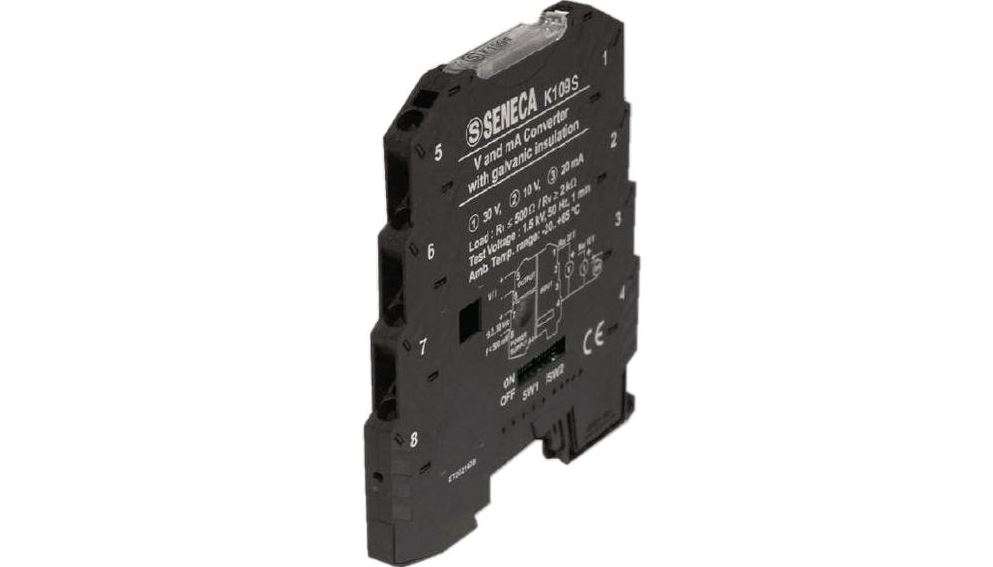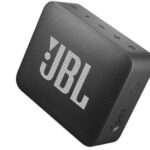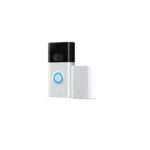SENECA Signal converter K109S User Manual

General Description
The K109S instrument is a V – mA converter with 4-point galvanic insulation designed for industrial standard voltage or current signals with passive input, active output and auxiliary supply. Analog/digital conversion takes place at 14 bit on every input range. The instrument also provides the following functions:
- Auxiliary Supply, completely floating, isolated from the other ports, with voltage unrelated to the input power supply.
- Current or voltage input.
- Programmable rejection for 50 or 60 Hz mains frequency.
- Additional reading stabilisation filter.
- Inversion of the input and inverted output scales
- Input Out-of-Range programmable to 2.5% or 5.0%
- SQRT function.
- Linearisation for horizontal cylindrical tanks. The module is also characterised by its extremely compact size, coupling to 35 mm DIN rail, power supply available by bus, quick fit couplings by spring-type terminals, onsite configuration by DIP-switch.
Technical Features


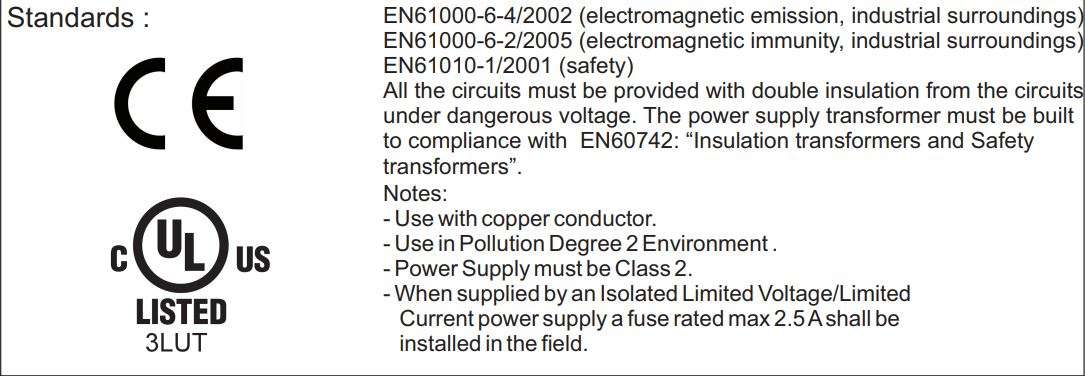
- No linearization function enabled.
- Linearization functions operate only in the 0..100% rated range, whereas for the under range and the over-range, the input signal is transferred without any alteration (G=1). Continuity and monotonic quality of transfer are guaranteed throughout the entire range of measurement.
- In the 0..1% range, the function is linear with gain G=10 in order to avoid overamplification of the noise.
Installation rules
This module has been designed for assembly on a DIN 46277 rail. Assembly in vertical position is recommended in order to increase the module’s ventilation, and no raceways or other objects that compromise aeration must be positioned in the vicinity. Do not position the module above equipment that generates heat; we recommend positioning the module in the lower part of the control panel or container compartment. We recommend rail-type assembly using the corresponding bus connector (Code K-BUS) that eliminates the need to connect the power supply to each module.

Using the K-BUS connector
- Compose the K-BUS connectors as required in order to obtain the number of positions necessary (each K-BUS permits the insertion of no. 2 modules).
- Insert the K-BUS connectors in the rail by positioning them on the upper side of the rail and then rotating them downwards. IMPORTANT: Pay particular attention to the position of the protruding terminals of the K-BUS. The K-bus must be inserted in the guide with the protruding terminals on the left (as shown in the figure) otherwise the modules are turned upside downs.
⚠ – Never connect the power supply directly to the bus connector on the DIN rail.
– Never tap power supply from the bus connector either directly or by using the module’s terminals.
SETTING OF THE DIP-SWITCHES
Factory setting
All the module DIP switches are at pos. 0 as defaut configuration. This set correspond to the following configuration :
Input signal arrow → 0..20 mA
50-60 Hz mains frequency rejection → 50 Hz
Input filter → Present
Inversion → No
Linearisation → None
Output signal → 0..20 mA
Input Out-of-range → ± 5% limit
It is understood that this configuration is valid only with all the DIP switches at position 0. Even as one Dip is moved, it is necessary to set all the other parameter as indicated on the following tables.
Note: for all following tables The indication indicates that the DIP-switch is set in Position 1 (ON). No indication is provided when the DIP-switch is set in Position 0 (OFF).
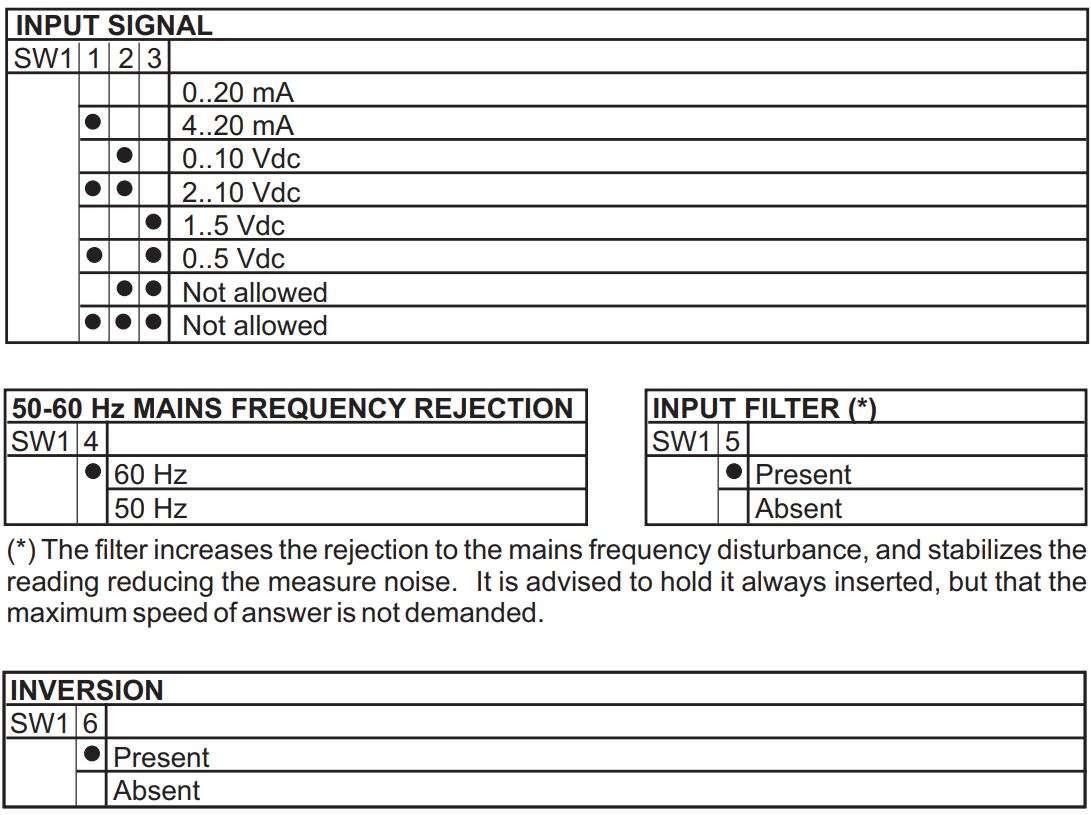
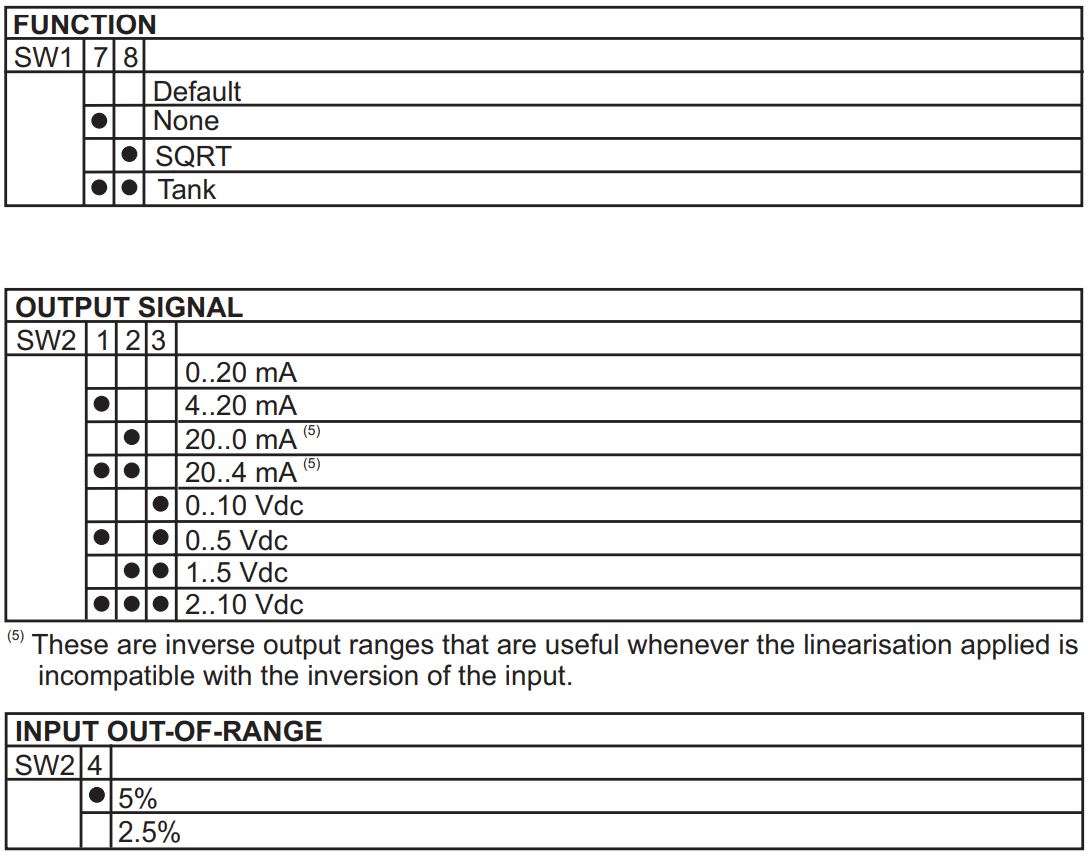
Input Output Limits
The Out-of-Range Limits provided in the following table are applied to the input signal, whereas the fixed limits are applied to the output signal: 0..21 mA, 0..5,25 Vdc, 0..10,5 Vdc.

Electrical Connections
The module has been designed for spring-type terminal electrical connections. Proceed as follows to make the connections:
- Strip the cables by 0.8 mm
- Insert a screwdriver in the square hole and press it until the cable lock spring opens.
- Insert the cable in the round hole.
- Remove the screwdriver and make sure that the cable is tightly fastened in the terminal.
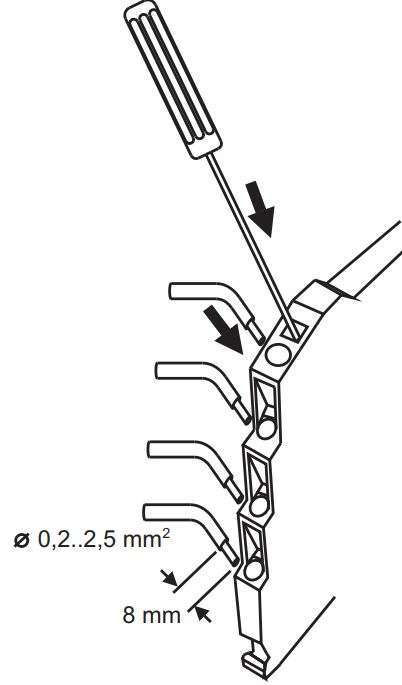
Power supply
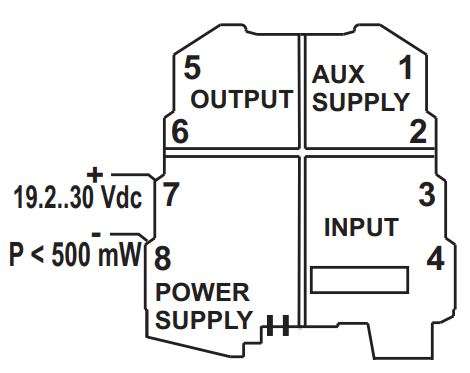
- Direct power supply to the modules by connecting 24 Vdc power supply directly to Terminals 7 ( + ) and 8 ( – ) of each module.
- Using the K-BUS connector accessory for the distribution of the power supply to the modules via bus connector, in this way eliminating the need to connect power supply to each module. The bus can be supplied from any of the modules; the total absorption of the bus must be less than 400 mA. Higher absorption values can damage the module. An appropriately sized fuse must be connected in series to the power supply.
- Using the K-BUS connector accessory for the distribution of the power supply to the modules via bus connector and the K-SUPPLY accessory for the connection of the power supply. The K-SUPPLY accessory is a 6.2 mm wide module that contains a set of protections designed to protect the modules connected via bus against over-voltage loads. The bus connector can be provided with power using the K-SUPPLY module if the total absorption of the bus is less than 1.5 A. Higher absorption values can damage both the module and the bus. An appropriately sized fuse must be connected in series to the power supply.
Input and Auxiliary Power Supply
Input
The module accepts a current or voltage input signal. The use of shield cables is recommended for the electronic connections.
Voltage input
Terminal 3: Voltage input. Terminal 4: Return (GND).
Current input
Terminal 3: Current input. Terminal 4: Return (GND)
Auxiliary Power Supply
The value of the provided voltage is independent from the one supplied through 7 and 8 terminals.
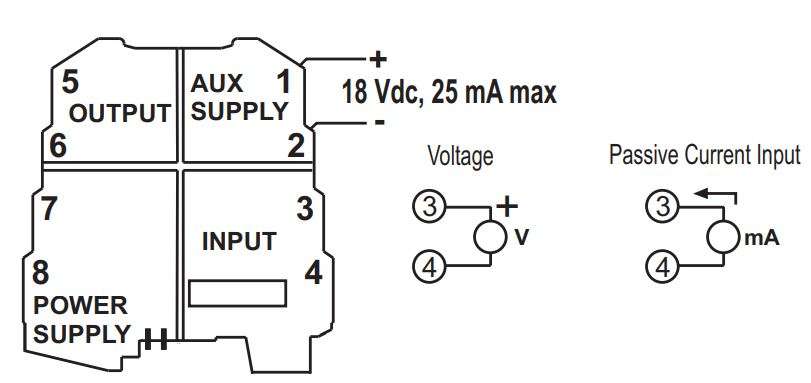
Output
Voltage connection – Current connection (applied current)
The use of shield cables is recommended for the electronic connections.
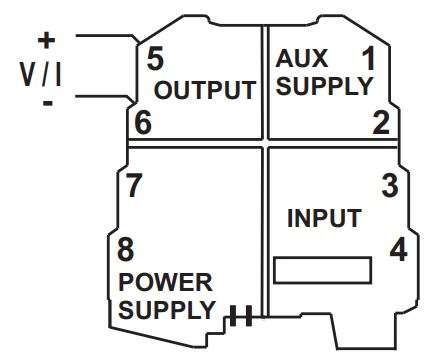
Note: in order to reduce the instrument’s dissipation, we recommend either using the output for voltage or guaranteeing a load of > 250 to the current output.
Examples of Active Input Connections
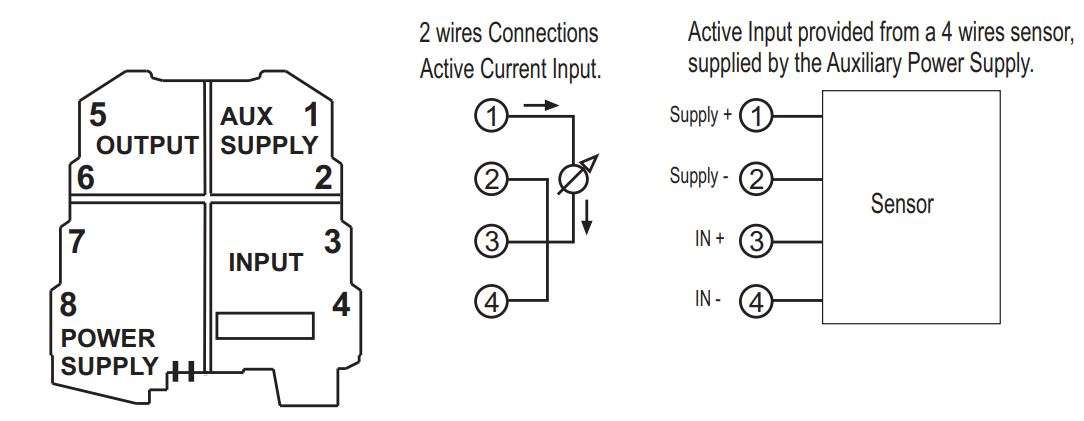
LED indications on the front


![]() Disposal of Electrical & Electronic Equipment (Applicable throughout the European Union and other European countries with separate collection programs) This symbol, found on your product or on its packaging, indicates that this product should not be treated as household waste when you wish to dispose of it. Instead, it should be handed over to an applicable collection point for the recycling of electrical and electronic equipment. By ensuring this product is disposed of correctly, you will help prevent potential negative consequences to the environment and human health, which could otherwise be caused by inappropriate disposal of this product. The recycling of materials will help to conserve natural resources. For more detailed information about the recycling of this product, please contact your local city office, waste disposal service or thè retail store where you purchased this product.
Disposal of Electrical & Electronic Equipment (Applicable throughout the European Union and other European countries with separate collection programs) This symbol, found on your product or on its packaging, indicates that this product should not be treated as household waste when you wish to dispose of it. Instead, it should be handed over to an applicable collection point for the recycling of electrical and electronic equipment. By ensuring this product is disposed of correctly, you will help prevent potential negative consequences to the environment and human health, which could otherwise be caused by inappropriate disposal of this product. The recycling of materials will help to conserve natural resources. For more detailed information about the recycling of this product, please contact your local city office, waste disposal service or thè retail store where you purchased this product.
This document is property of SENECA srl. Duplication and reprodution are forbidden, if not authorized. Contents of the present documentation refers to products and technologies described in it. All technical data contained in the document may be modified without prior notice Content of this documentation is subject to periodical revision.
![]() SENECA s.r.l. Via Austria, 26 – 35127 – PADOVA – ITALY Tel. +39.049.8705355 – 8705359 – Fax +39.049.8706287 e-mail: [email protected] – www.seneca.it
SENECA s.r.l. Via Austria, 26 – 35127 – PADOVA – ITALY Tel. +39.049.8705355 – 8705359 – Fax +39.049.8706287 e-mail: [email protected] – www.seneca.it
 www.logicbus.com | [email protected] | +1 619 616 7350
www.logicbus.com | [email protected] | +1 619 616 7350
Download PDF
SENECA Signal converter K109S User Manual PDF Download
